These candied orange peels are delicately sweet with a citrusy aroma and a delightfully chewy texture. As elegant as they look, they’re surprisingly easy to make at home! Use this simple 3-ingredient recipe to garnish cocktails, gift to friends and family, or dress up a holiday cookie tray.
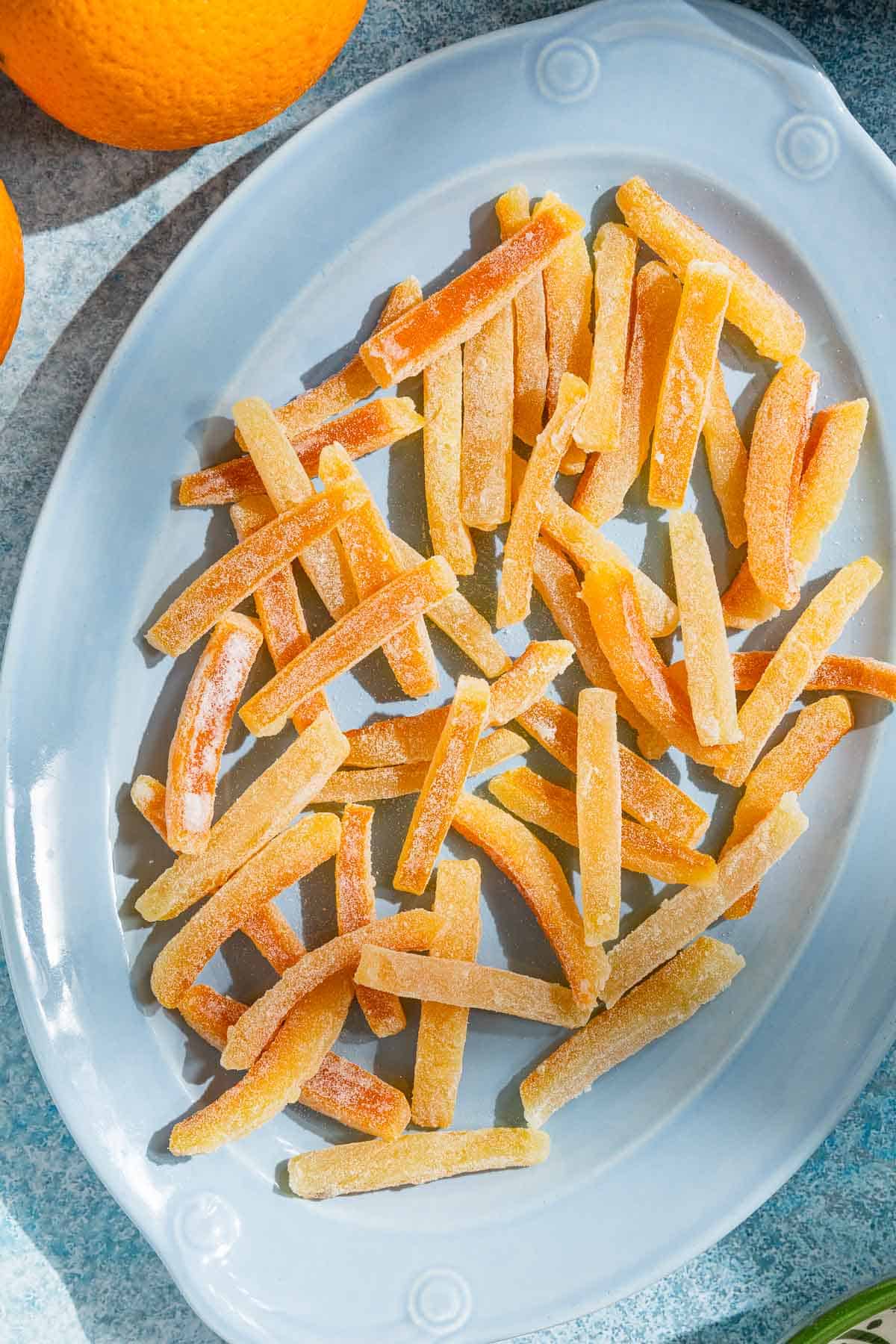
Candying fresh fruit in sugar is a centuries-old tradition, once used to preserve the fruit beyond its short-lived season. Historically, the cost of sugar relegated candied orange peels (or other kinds of candied fruit) to special occasions like holidays, either on their own or added to celebratory breads like Easter bread, fruit cake, or king’s cake.
In this candied orange peel recipe, the citrus peels are boiled to reduce bitterness from the pith. Then you simmer in simple syrup until tender, coat in sugar, and leave to dry overnight. That’s it! The best part: the candied peels last for up to 3 months eat them candied or dip them in chocolate for an extra decadent treat. Save the orange-scented syrup to elevate pancakes, cocktails, baked pears, French toast, or even fruit salad.
While the cost of sugar has come down, candied fruit’s association with the holidays stuck. It’s no wonder their sweet-tart flavor can brighten the darkest time of year! Like sugared cranberries, these chewy delights make a dazzling addition to holiday cookie platters or a festive gift for friends and family.
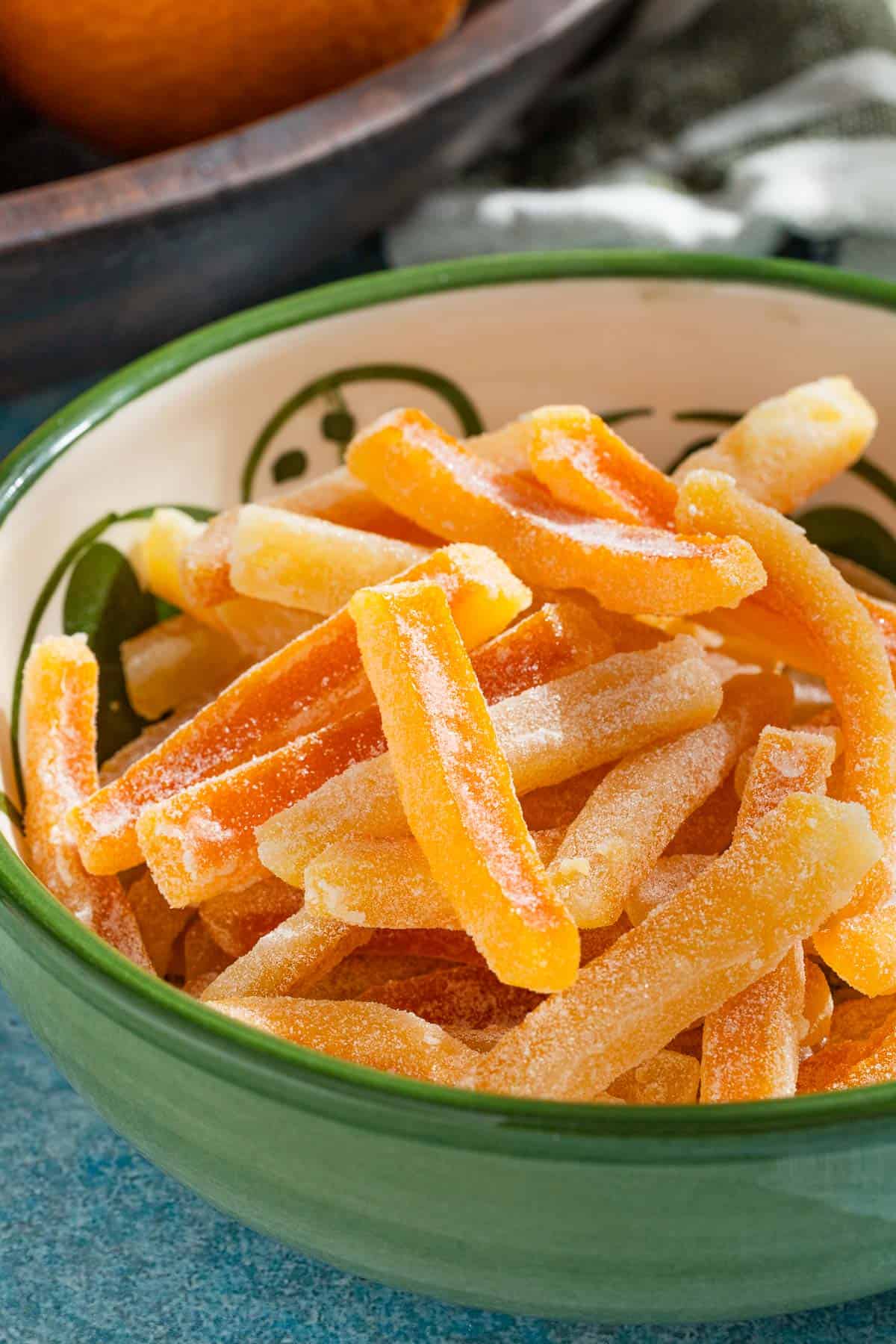
Table of Contents
Food Stories: La Boqueria Market, Barcelona
Walking through the main entrance to La Boqueria market in Barcelona, a stand on the right of the center aisle always inevitably caught my eye. It’s a feat in such a bustling market! But it was hard to ignore the glimmer of the vibrant, shiny candied fruits.
There, vendors sell everything from red and green maraschino cherries to all sorts of candied citrus peels, slices, and even whole candied oranges. While candying a whole orange might be better left for the pros, candied orange peels are surprisingly hands-off and easy, even if they require some patience.
And, it’s well worth it: You’re left with an edible gift that’s just as beautiful as a Spanish market, but with the charm that can only come from a homemade confection.
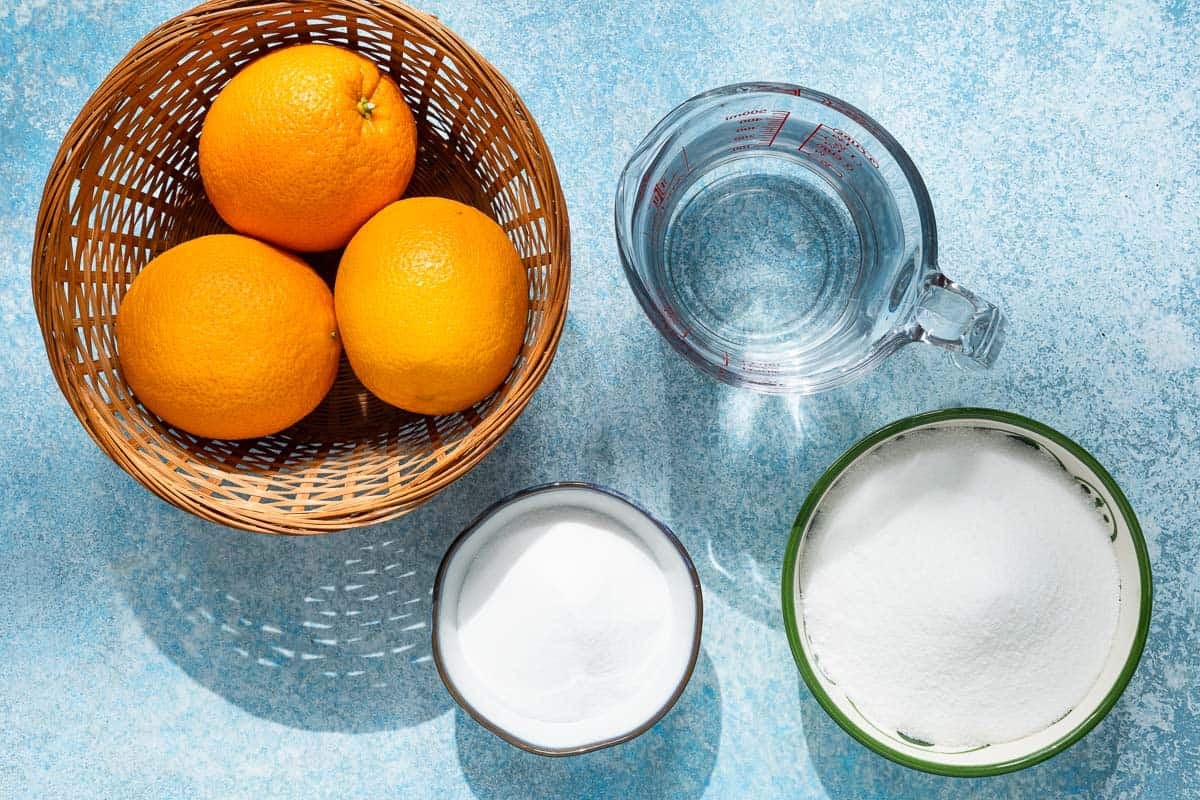
Candied Orange Peel Ingredients
All you need to make candied orange peel are oranges, sugar, and water. I call for two types of sugar, granulated for candying and fine to give the candied oranges an extra polished touch.
- Oranges: You can use any type of orange. Because you’ll be using the rind, it’s best to use organic oranges to avoid chemicals sprayed on the fruit.
- Granulated sugar: I use granulated sugar for the syrup because it’s free from impurities that could burn during the long cooking time and has a neutral flavor that lets the orange shine.
- Superfine sugar: Also known as caster sugar or baker’s sugar, superfine sugar is finer than granulated sugar but not quite powdered. It gives the candied orange peels an elegant finish. If you can’t find superfine sugar, you can put granulated sugar in a food processor and pulse it until the granules are reduced to the site of table salt. Don’t over process or you’ll end up with powdered sugar.
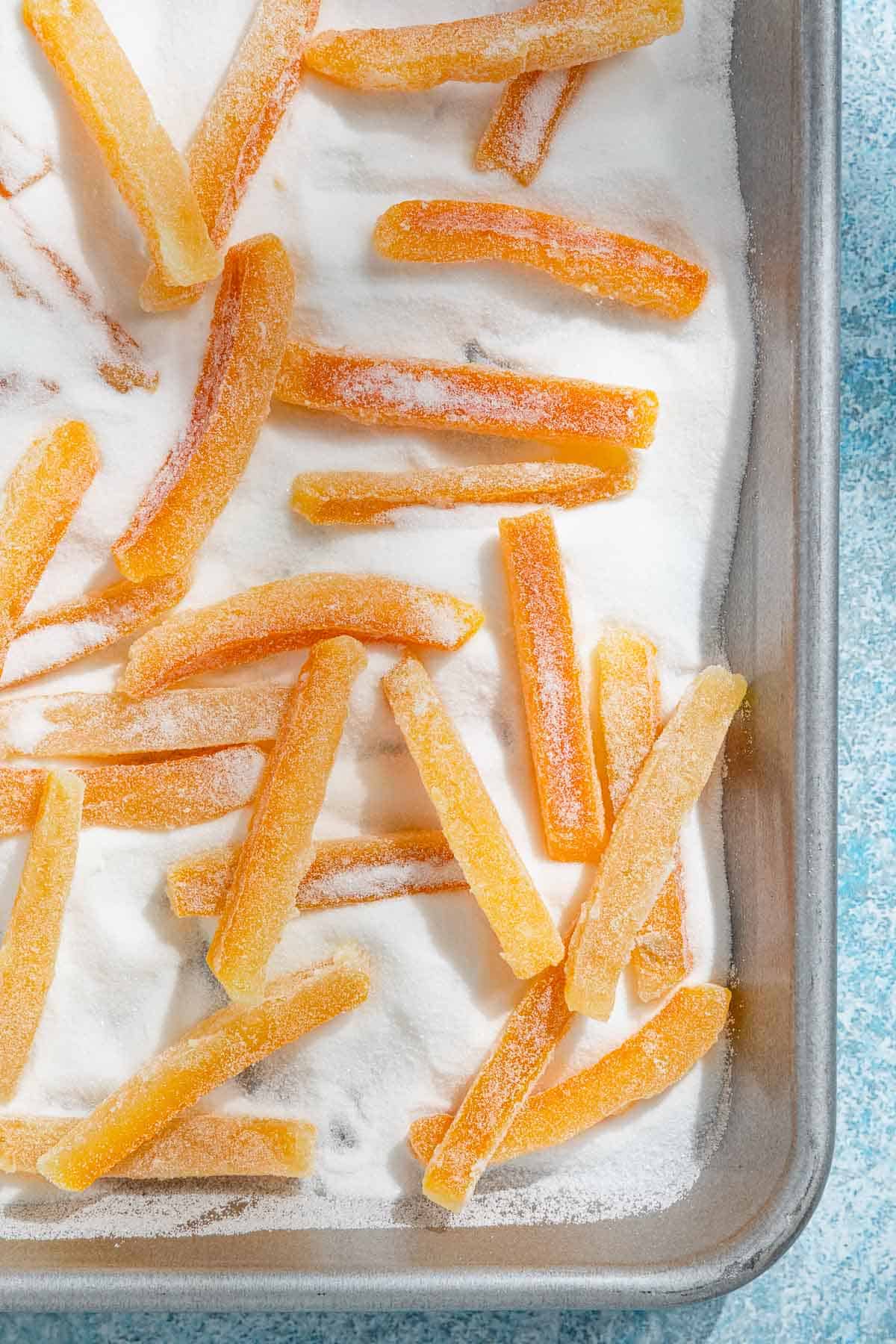
How to Make this Candied Orange Peel Recipe
Making homemade candied orange peels doesn’t take much work, but it will require some patience. It takes about 45 minutes for the peels to candy (this is when I snack on the oranges), then you need to wait until they dry, about 12 to 24 hours.
- Prepare the peel. Cut off the top and bottom of each orange with a sharp knife. Make 4 vertical incisions through the peel and pith on both oranges trying not to cut into the fruit.
- Separate the peel. Use your fingers to separate each quarter of the peel, including the pith, from the fruit. The peel should separate relatively easily from the fruit without tearing.
- Slice into strips. Use the knife to slice the peel lengthwise into 1/4-inch-wide pieces.
- Boil the peel. Add the orange peel slices to a medium saucepan and add enough cold water to cover the peels by an inch. Bring to a boil over high heat. Reduce the heat to a simmer and continue to cook for 15 minutes. Drain the peels.
- Repeat (optional). You can choose to boil up to 2 more times to remove more bitterness from the peel before candying. With oranges, you can blanche the peels just once or twice if you want to save time, but with more bitter citrus fruits, such as lemons, limes, or grapefruit, I recommend repeating the step twice.
- Make a sugar syrup. Clean out the saucepan. Add 2 cups each of granulated sugar and water and set over medium heat. The sugar will dissolve into a syrup and then come to a boil.
- Add the peels. Once the syrup begins to boil, carefully drop in the orange peels and reduce the heat to low. Cook the peels, adjusting the heat as necessary to maintain a constant, gentle simmer.
- Simmer. Cook for 45 minutes, until the orange peels are soft and the pith starts to turn translucent. The syrup will have thickened, and the bubbles will be thick and glass-like. You can also use a candy thermometer to check for doneness—the syrup should register between 235°F – 245°F (soft ball stage).
- Drain. Take the pan off the heat. Once the syrup stops bubbling, carefully strain the peels, saving the syrup in a heatproof measuring cup for another use (see “Save Your Leftover Orange Syrup!” below). I had about 1 cup of syrup.
- Coat the candied peels in sugar. Pour 1 cup of superfine sugar into a rimmed sheet pan or a wide, shallow bowl. Add the candied orange peels and use a small set of tongs or a couple of forks to toss them in the sugar to coat, separating them if they stick together.
- Let the peels dry. Spread the candied orange peels in a single layer on a parchment-lined sheet pan or on a nonstick wire rack. Let them sit uncovered at room temperature until dried, overnight or at least 12 hours. They’re ready when they no longer feel tacky and don’t stick to each other.
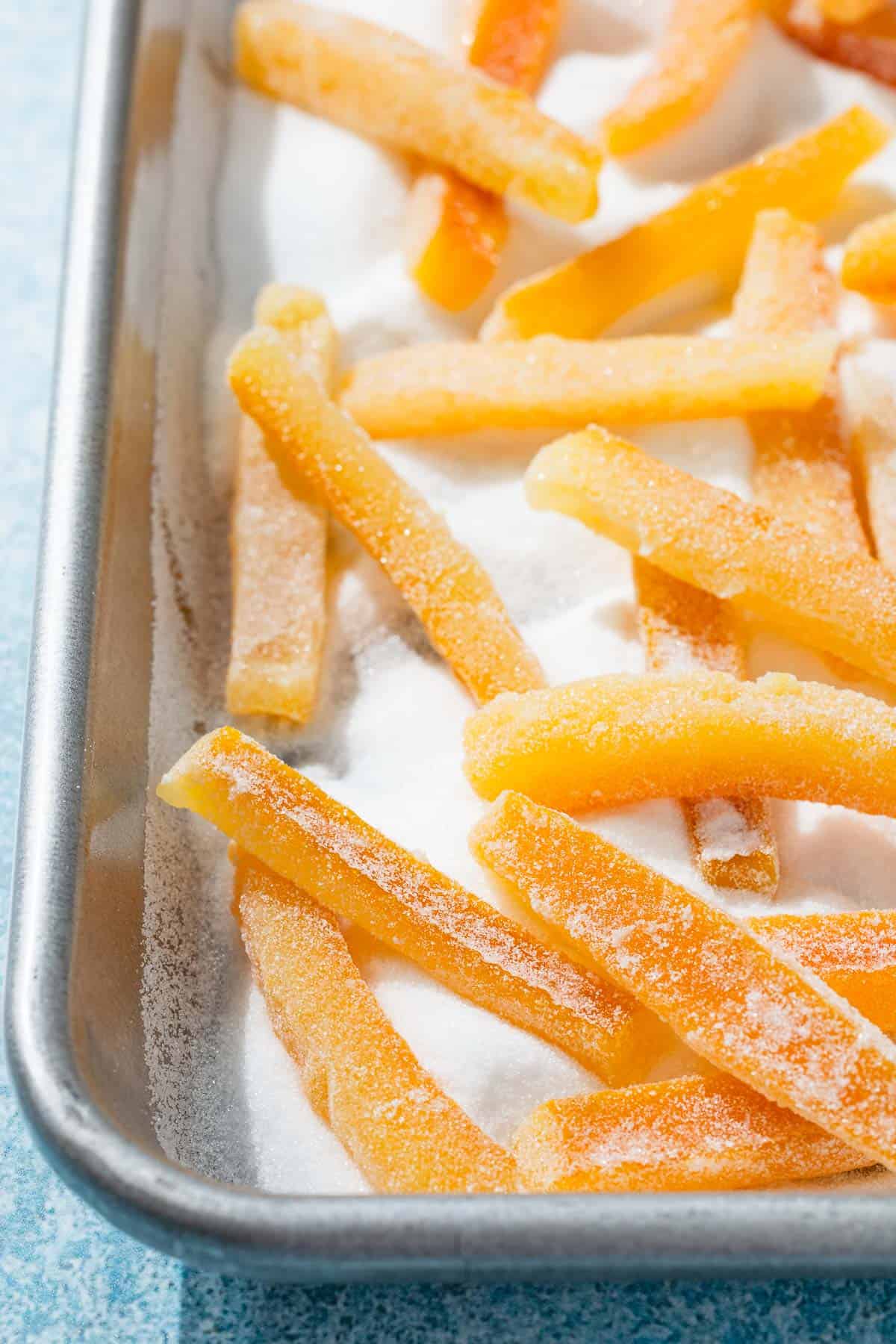
Save Your Leftover Orange Syrup and Oranges!
Don’t throw out the orange syrup that’s left after making candied orange peel! It’s delicately sweet, fragrant, and bursting with bright orange flavor. It can replace simple syrup in cocktails, mocktails, and lemonade. You can also use it to replace honey or maple syrup on pancakes, baked pears, French toast, or even fruit salad.
After cooking, the orange syrup is quite concentrated and sweet. You can either use less syrup than you typically use, or dilute by combining with 1/4 cup of water in a small saucepan. Bring to a simmer, then cool and drain through a sieve into a bottle or airtight container. It will keep in the fridge for up to 2 weeks.
Use the leftover oranges for salads, like Mediterranean orange and pomegranate salad or fresh fennel orange salad. Or you can juice them for roast spatchcock chicken or mango smoothies (you can freeze the juice for later if you’d like). Or keep the dessert train going with orange ricotta cake, Greek honey cake, or orange cardamom olive oil cake.
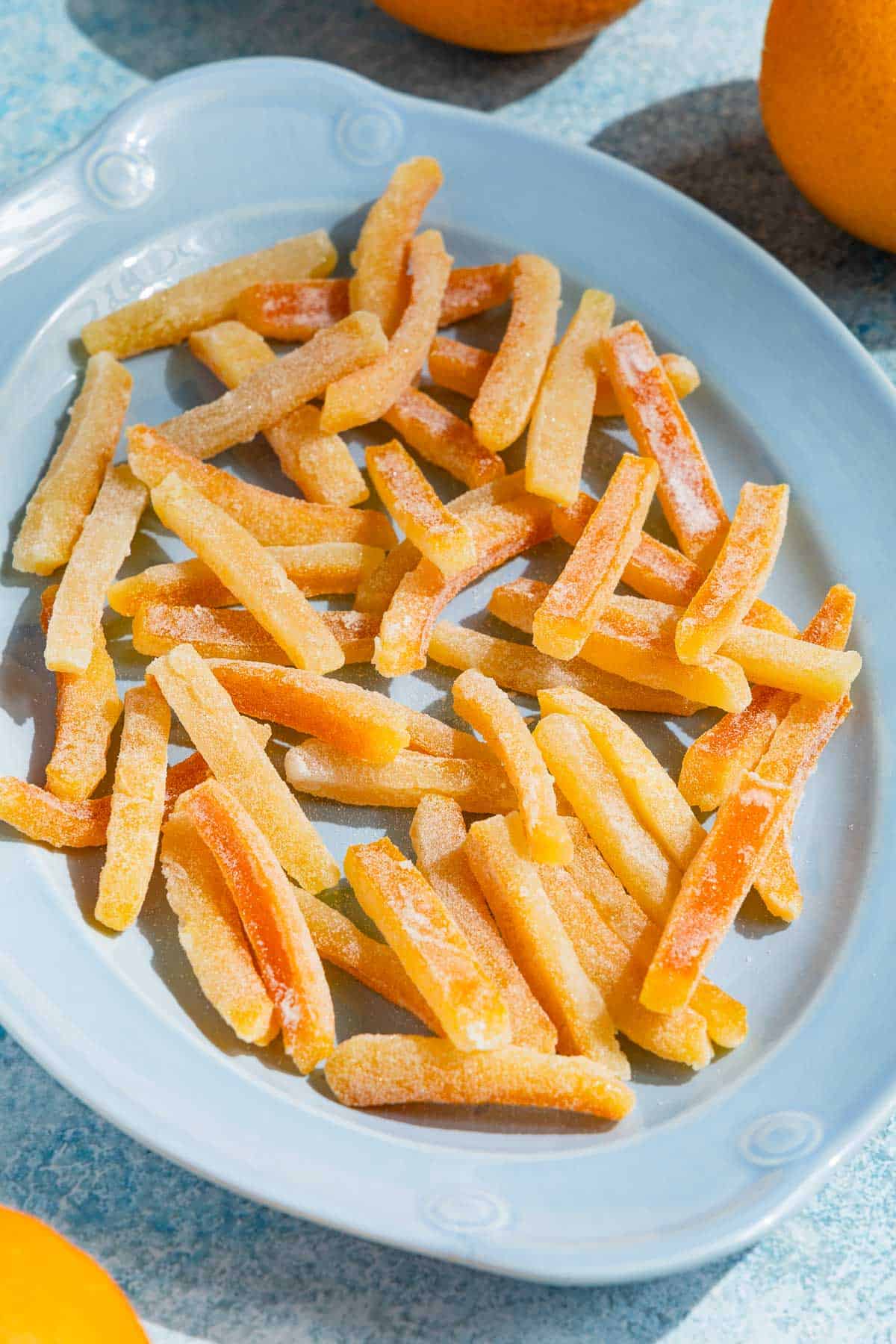
Don’t Stop At Oranges! Ways to Mix it Up
This candied orange peel recipe is very versatile: you can use it for most citrus, from lemons, grapefruit, limes, or almost any other interesting seasonal citrus like mandarins, tangerines, and kumquats.
For citrus fruits that are more bitter than oranges, blanch the peels two to three times before candying.

How to Use Candied Orange Peels
On their own as a snack, candied orange peels are just like sugar-coated jelly candies but better. Because they’re homemade, they taste like real oranges instead of orange flavor. You can also incorporate them into also sorts of recipes:
- To elevate dessert. Use the peels as a garnish with a dessert, like orange cardamom cake, olive oil chocolate mousse, or chocolate cake. And if you’re a big citrus-lover, they’re absolutely perfect on top of our orange loaf cake.
- To give cocktails a restaurant-quality flair. Garnish your cocktails or mocktails with a fancy twist, from gin cocktail to a bittersweet negroni or even a Carajillo (Spiked Coffee).
- Even breakfast! Dice the candied orange peels and toss into a finished batch of homemade olive oil granola.
- For holiday parties and cookie trays. They’re not just delicious, but they add beautiful orange sparkle to the dessert table. Because they’re vegan (if you use organic sugar) and gluten-free, they’re a sweet, festive treat that everyone can indulge in. To add even more of a festive flair dip the half of each candied orange peel in dark chocolate. Place them on your dessert tray alongside cinnamon-scented candied nuts, sugared cranberries, and Turkish delight!
- For gifting. With how well they keep, they’re also a great gift to give to friends or include in cookie boxes.
Make A Holiday Dessert Tray!
Browse all Mediterranean recipes.
Visit Our Shop
Get The Mediterranean Dish Cookbook
More than 120 recipes for bright and flavorful Mediterranean diet-inspired meals.

Candied Orange Peel

Ingredients
- 3 large oranges (you'll use the skin, so untreated/organic is preferred)
- 2 cups (400g) granulated sugar
- 1 cup superfine (caster) sugar
Instructions
- Prepare the peel. Cut off the top and bottom of each orange with a sharp knife. Make 4 vertical incisions through the peel and pith on both oranges without cutting into the fruit. Use your fingers to separate each quarter of the peel, including the pith, from the fruit. The peel should separate relatively easily from the fruit without tearing. Use the knife to slice the peel lengthwise into 1/4-inch-wide pieces.
- Boil the peel. Add the orange peel slices to a medium saucepan and add enough cold water to cover the peels by one inch. Bring to a boil over high heat, then reduce the heat to a simmer and continue to cook for 15 minutes. Drain the peels. If your fruit is very bitter, repeat this step up to 2 more times (see note)
- Make the sugar syrup. Clean out the saucepan. Add the sugar and 2 cups of water and set over medium heat. The sugar will dissolve into a syrup and then come to a boil.
- Candy the peels. Once the syrup begins to boil, carefully drop in the orange peels and reduce the heat to low. Cook the peels, adjusting the heat as necessary to maintain a constant, gentle simmer. Cook for 45 minutes, until the orange peels are soft and the pith starts to turn translucent. The syrup will have thickened, and the bubbles will be thick and glass-like. You can also use a candy thermometer to check for doneness—the syrup should register between 235°F – 245°F (soft ball stage).
- Drain. Take the pan off the heat. Once the syrup stops bubbling, carefully strain the peels over a heatproof bowl. Reserve the syrup for another use (see note).
- Coat the candied peels in sugar. Pour the superfine sugar into a rimmed sheet pan or a wide, shallow bowl. Add the candied orange peels and use a small set of tongs or a couple of forks to toss them in the sugar to coat, separating them if they stick together.
- Let the peels dry. Spread the candied orange peels in a single layer on a parchment-lined sheet pan or on a nonstick wire rack. Let them sit uncovered at room temperature until dried, overnight or at least 12 hours. They’re ready when they no longer feel tacky and don’t stick to each other.
- Storage. Once dried, store candied orange peels in an airtight container at room temperature for up to 1 month, or up to 3 months in the freezer.
Notes
- You can choose to boil the peels up to 3 times to remove more bitterness before candying. With oranges, you can blanche the peels just once or twice to save time, but with more bitter citrus fruits, such as lemons, limes, or grapefruit, I suggest repeating the step twice.
- The resulting syrup can replace simple syrup in cocktails, mocktails, lemonade, iced tea and more. You can also use it to replace honey or maple syrup on pancakes, baked pears, French toast, or even fruit salad.
- Note: The syrup will be more concentrated than a typical simple syrup. To dilute, combine it with 1/4 cup of water and bring it to a simmer in a small saucepan. Cool and strain it through a sieve into a bottle or airtight container. It will keep in the fridge for up to 2 weeks.
- If you can’t find superfine sugar, put an equal amount of granulated sugar into a food processor and pulse until the granules resemble fine table salt. Do not over process or you will end up with powdered sugar.
- Visit our shop to browse quality Mediterranean ingredients including olive oils, honey, jams, and spices.



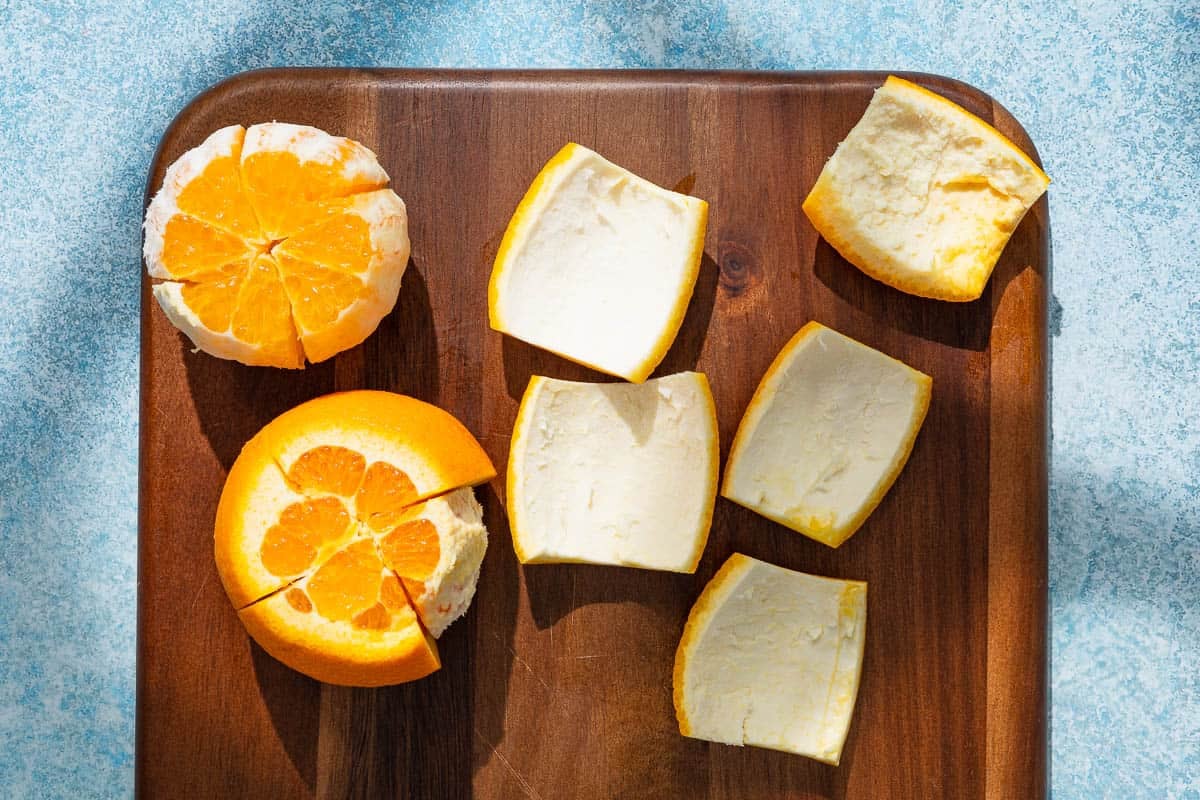
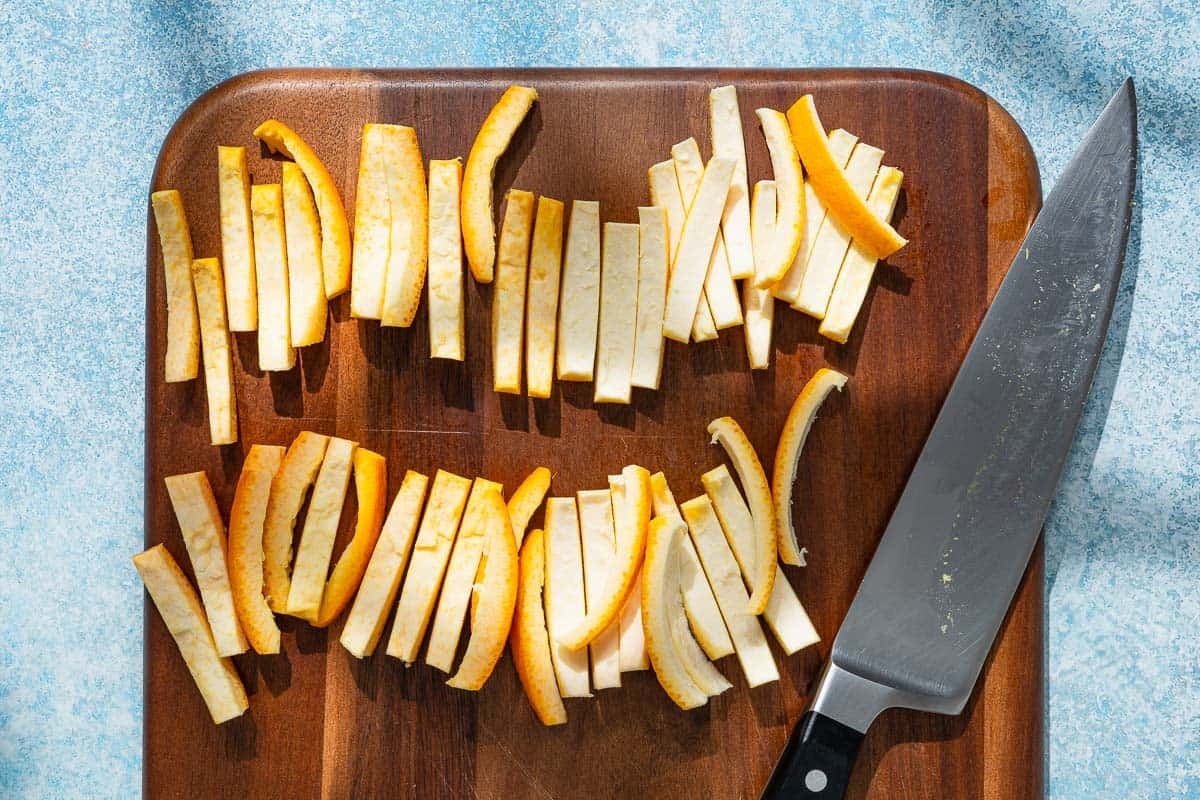
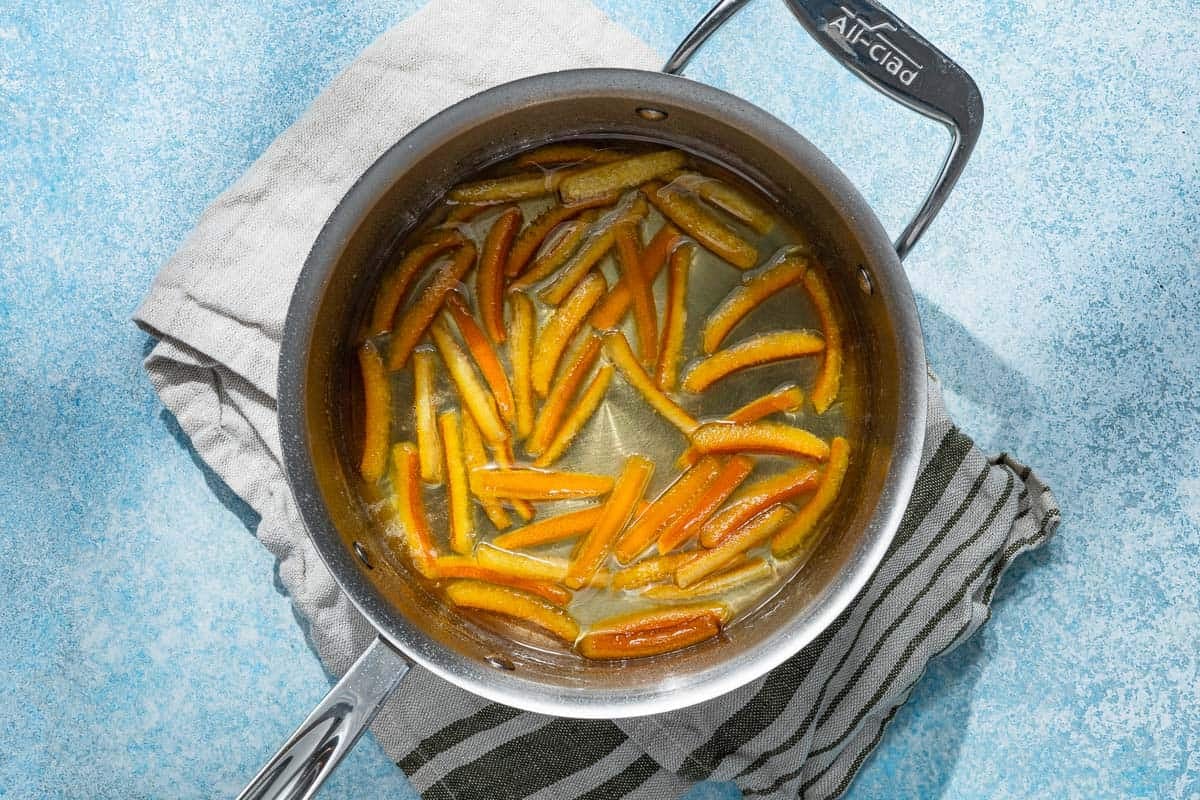
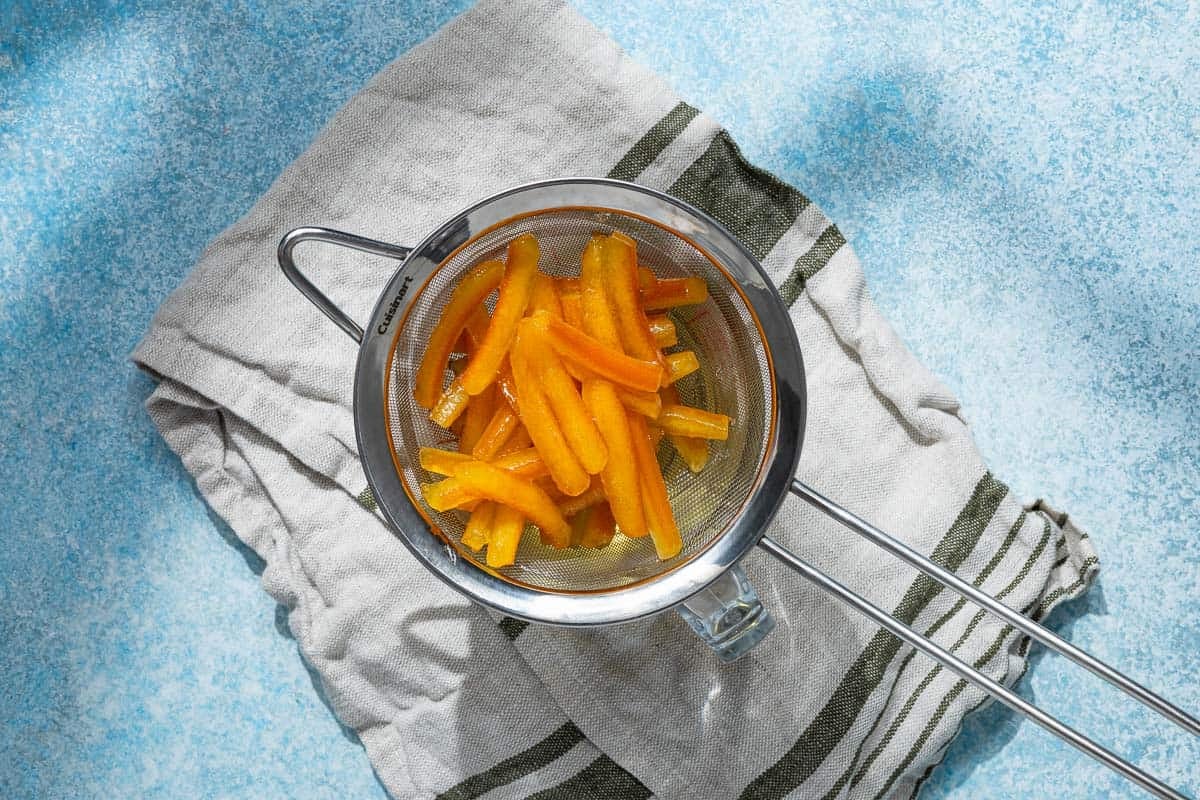
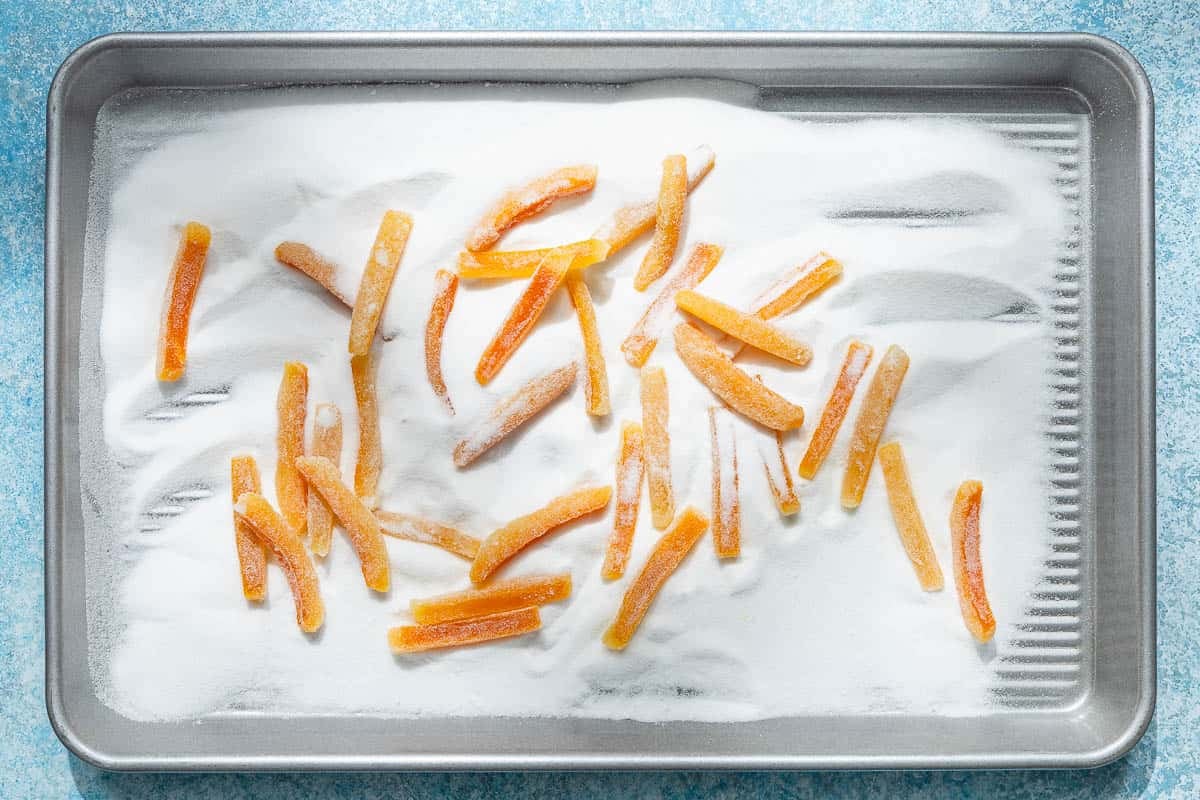




How long does it keep?
Hi, Mary. Once dried, store candied orange peels in an airtight container at room temperature for up to 1 month, or up to 3 months in the freezer.
4 stars only because the serving size was not listed al8ng with nutritional information. Otherwise I would say five stars and call it both extremely tasty and freshening as well as useful in so many ways. LEFTOVER SUGAR AND SYRUP CAN BE USED IN A MANY WAYS AS WELL.
A bit laborious but end result is quite worth it! I added a smidge of cinnamon to the water, * think rosewater would also be good. Having no tongs handy, I shook the peels in a bag with sugar to coat. So delicious!
Yay! Thanks so much!
Hi, can I use sugar substitute for the orange peel?
Hi, Yaffa. There may be a suitable sugar substitute that would work for this, but it’s just something we’ve tested before. If you decide to give it a try, please stop back and let us know how it went!
I made these last night. The texture is amazing. I just wish they had more orange flavor to them. I’m going to try squeezing some juice in the sugar syrup next time and see what that does! Great jumping off point for sure
So amazingly wonderful!
I made these for the first time and they are absolutely wonderful ! It beats any store bought versions I ever tasted. Thanks for the wonderful recipe and walk through.
My little twist: some will be used to stuff beautiful and delicious dates. Yum!
Hi Valerie, Devin here from the Mediterranean Dish team. We have a stuffed dates go-to that’s more on the savory side with goat cheese, walnuts, Aleppo pepper and honey. This sweet version sounds FANTASTIC and so, so pretty! Thank you for the tip!